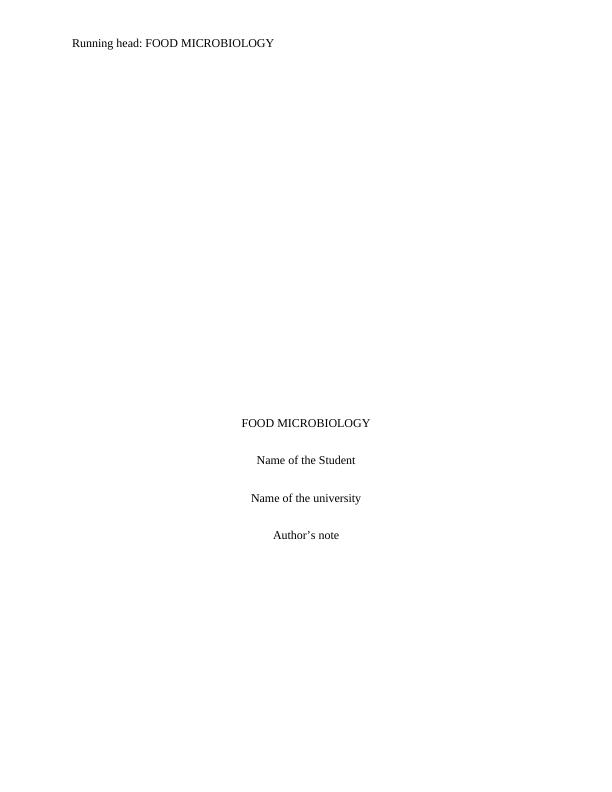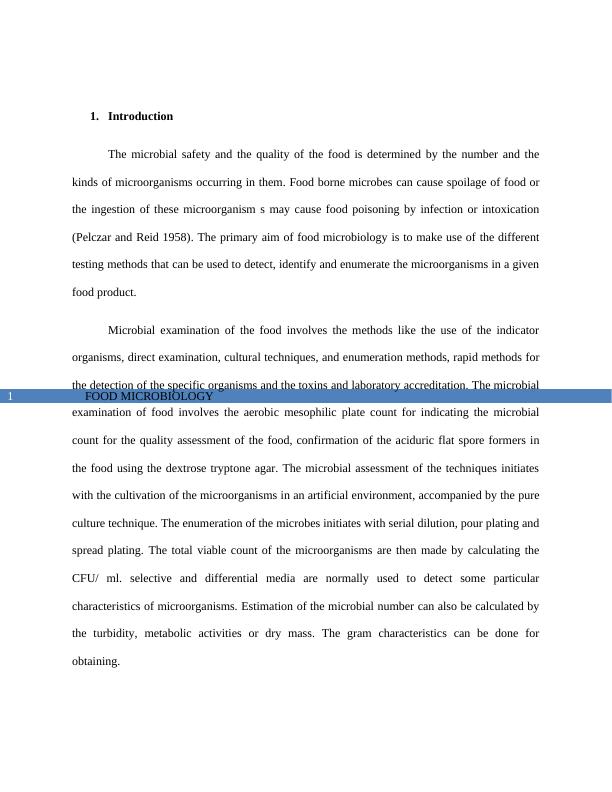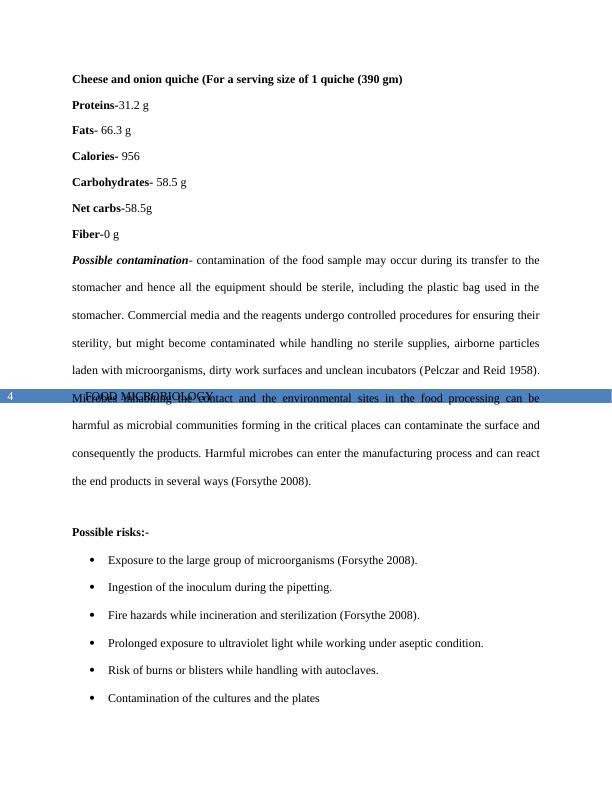Food Microbiology - Sample Assignment
29 Pages5686 Words364 Views
Added on 2021-06-17
Food Microbiology - Sample Assignment
Added on 2021-06-17
ShareRelated Documents
Running head: FOOD MICROBIOLOGYFOOD MICROBIOLOGYName of the StudentName of the universityAuthor’s note

FOOD MICROBIOLOGY11.IntroductionThe microbial safety and the quality of the food is determined by the number and thekinds of microorganisms occurring in them. Food borne microbes can cause spoilage of food orthe ingestion of these microorganism s may cause food poisoning by infection or intoxication(Pelczar and Reid 1958). The primary aim of food microbiology is to make use of the differenttesting methods that can be used to detect, identify and enumerate the microorganisms in a givenfood product. Microbial examination of the food involves the methods like the use of the indicatororganisms, direct examination, cultural techniques, and enumeration methods, rapid methods forthe detection of the specific organisms and the toxins and laboratory accreditation. The microbialexamination of food involves the aerobic mesophilic plate count for indicating the microbialcount for the quality assessment of the food, confirmation of the aciduric flat spore formers inthe food using the dextrose tryptone agar. The microbial assessment of the techniques initiateswith the cultivation of the microorganisms in an artificial environment, accompanied by the pureculture technique. The enumeration of the microbes initiates with serial dilution, pour plating andspread plating. The total viable count of the microorganisms are then made by calculating theCFU/ ml. selective and differential media are normally used to detect some particularcharacteristics of microorganisms. Estimation of the microbial number can also be calculated bythe turbidity, metabolic activities or dry mass. The gram characteristics can be done forobtaining.

FOOD MICROBIOLOGY2The first decision is to make during the microbial testing of the food involves - A surface sampleor a homogenized sample of food. Surface sampling- 1. Swabbing2. Contact plates3. Excision method.Homogenization method - this can be done by using the blender or a Colwell stomacher. Methods for determining the microbial count- 1. Standard plate count (SPC) (Pelczar and Reid 1958)2. Spiral plate counter3. Dry petrifilm4. Most probable numbers 5. Dye reduction numberImportance of the microorganismsThe importance of the microorganisms should not be overemphasized as it is known thatmicroorganisms constitutes of about 50 % of the earth’s biological carbon and 90 % of thebiological nitrogen of the earth (Pelczar and Reid 1958). They are present everywhere from thegeothermal vents and the ocean depths to the coldest part of the Arctics and the human skin.These microbes not only helps to maintain a healthy gut but also helps in the production of thevitamin B ad K. They can be necessary for the production of bread, cheese, antibiotics, vaccines

FOOD MICROBIOLOGY3enzymes and other important products. In fact the modern biotechnology depends upon themicrobiological foundation. Although most of the microorganisms play beneficial roles some ofthem are deadly and have disrupted the human population over the millennia. Classification of bacteriaBacterial is a type of biological cells that consists of a large number of prokaryoticmicroorganism. Bacteria can be classified in to 5 groups on the basis of their shapes- Cocci(spherical shaped), Bacilli (rod shaped), Spirilia (spiral shaped), vibrios (Comma shaped),spirochaetes (corkscrew). These bacteria may exist in pairs, single chains and clusters. Depending upon the staining reaction by the gram stain with the bacterial cell wall it canbe classified as the gram negative and the gram positive bacteria. Bacteria can also be classified on the basis of the temperature responses- Thepsychrophilic bacteria, the mesophilic bacteria and thermophilic bacteria. Bacterial classificationcan also be made on the basis of the number of flagella present, such as the Atrichos, themonotrichous, the lophotrichous, the amphitricous and the petritrichous. Bacteria can also be classified on the basis of their types of nutrition such as the autotrophicbacteria (the photoautotrophes and the chemoautotrophes) and the heterotrophic bacteria. Aim of the ExperimentThe aim is to use testing methods that are suitable to detect, enumerate and identifymicroorganisms in food products (cheese and onion)2. A concise characterization of cheese and onion quiche food sample

FOOD MICROBIOLOGY4Cheese and onion quiche (For a serving size of 1 quiche (390 gm)Proteins-31.2 gFats- 66.3 gCalories- 956 Carbohydrates- 58.5 gNet carbs-58.5gFiber-0 gPossible contamination- contamination of the food sample may occur during its transfer to thestomacher and hence all the equipment should be sterile, including the plastic bag used in thestomacher. Commercial media and the reagents undergo controlled procedures for ensuring theirsterility, but might become contaminated while handling no sterile supplies, airborne particlesladen with microorganisms, dirty work surfaces and unclean incubators (Pelczar and Reid 1958).Microbes inhabiting the contact and the environmental sites in the food processing can beharmful as microbial communities forming in the critical places can contaminate the surface andconsequently the products. Harmful microbes can enter the manufacturing process and can reactthe end products in several ways (Forsythe 2008). Possible risks:-Exposure to the large group of microorganisms (Forsythe 2008).Ingestion of the inoculum during the pipetting. Fire hazards while incineration and sterilization (Forsythe 2008).Prolonged exposure to ultraviolet light while working under aseptic condition. Risk of burns or blisters while handling with autoclaves. Contamination of the cultures and the plates

FOOD MICROBIOLOGY5Measures:-Laboratory safety protocols should be maintained such as using a lab coat while enteringthe laboratory, proper hand rubbing by using alcohol swabs.Refrain from talking in front of the culture plates to avoid contamination. Hair and any clothing should be properly tied to avoid any contamination and firehazards. All the reagents and the media should be properly sterilized (autoclave, sterile filter)The cell culture hood should be set properly and located in the area that is restricted tothe cell cultures free from the doors and the other equipment. The work surface should be uncluttered and should only contain the items that requiredfor the procedure. It is necessary to wipe the work surfaces with 70 % of ethanol. Ultraviolet light can be used to sterilize the air; working under the laminar airflow. All the pipetting of the inoculum should be done by using the sterile pipettes. Care should be taken while the plating method, proper inceration of the loops and thespreader should be made while spreading or isolating (Pelczar and Reid 1958). Microbial cross contamination can have detrimental effects in the food processingindustry and can cause the occurrence of the food borne-illness. Contamination of the foodwith harmful exotoxins such as Botullinum toxin can be lethal for people (Brown andStringer 2002). Food borne intoxication such as staphylococcal food poisoning is one of themain food poisoning that causes in United States. Campylobacter jejuni is another gramnegative bacteria that causes food borne diarrhea by the creation of an exotoxin. In order tomitigate the chance of food contamination it is necessary to assess the types ofmicroorganism present in the food items (Pelczar and Reid 1958).

End of preview
Want to access all the pages? Upload your documents or become a member.
Related Documents
Microbiology of Food Productslg...
|21
|4661
|253
Isolation Cultivation and Counting of Microorganisms Assignment PDFlg...
|23
|3242
|277
Methods for Microorganism Enumeration and Factors Affecting Growthlg...
|4
|1279
|72
BHS002: Microbiology & Biochemistrylg...
|18
|3640
|253
Standard Plate Counts and IMViC Tests for Bacterial Contamination in Minced Chickenlg...
|4
|695
|441
Microbiology Assignment: Microbial Analysis of Raw Fishlg...
|22
|4653
|250
